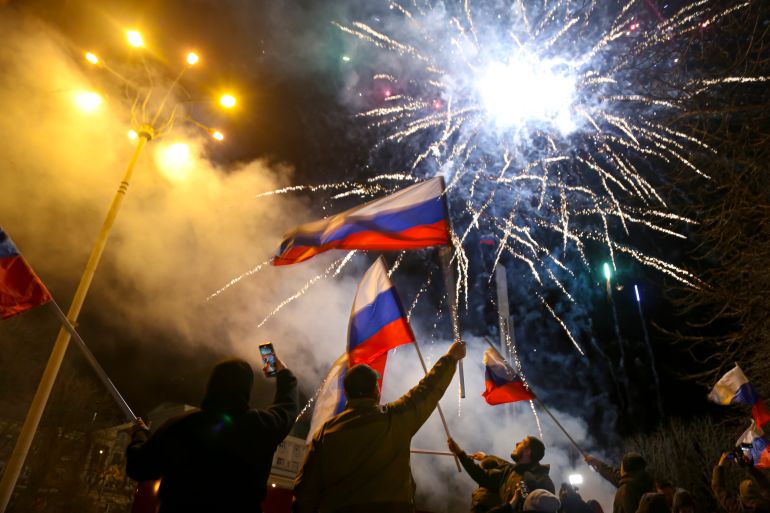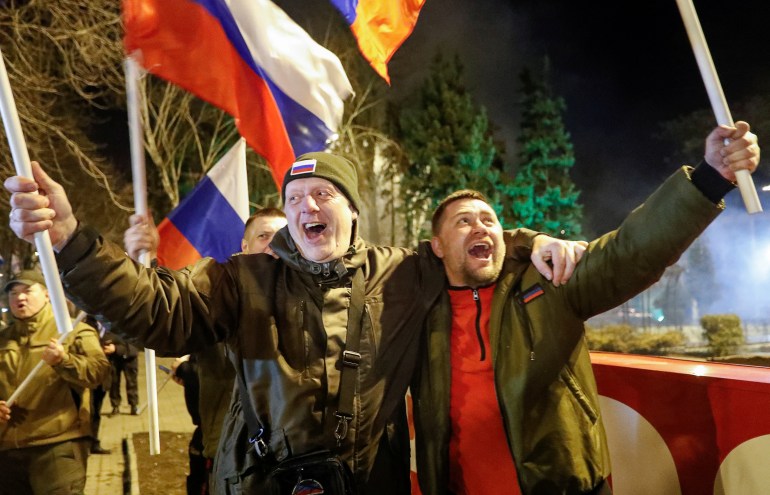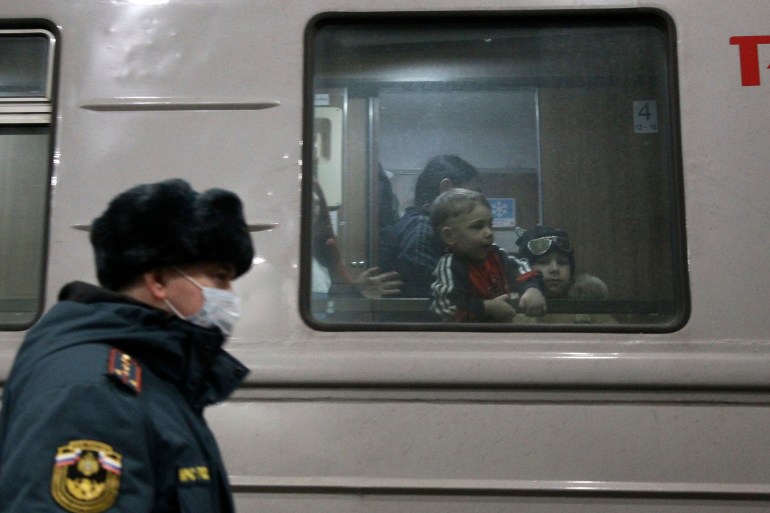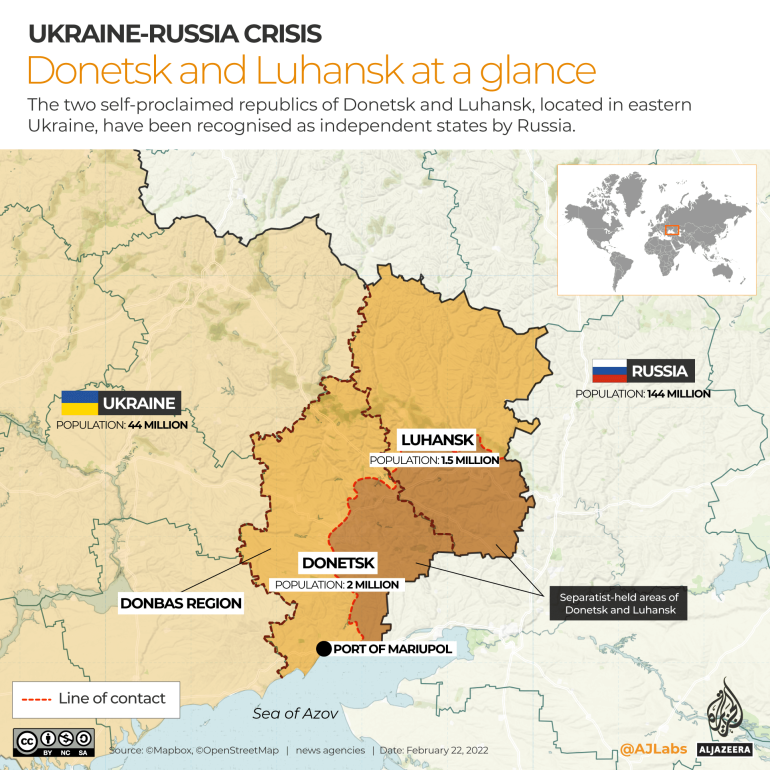Donetsk and Luhansk: What you should know about the ‘republics’
Who has followed Russia in recognising the controversial, Moscow-backed statelets in Ukraine? And what is life like there?

Kyiv, Ukraine – Moscow-backed separatists have controlled the southeastern Ukrainian regions of Donetsk and Luhansk, known collectively as Donbas, for almost eight years.
But Russian President Vladimir Putin recognised them only on Monday, paving the way for the official presence of Russian troops in the rebel-controlled areas that occupy about a third of Donetsk and Luhansk.
Keep reading
list of 4 itemsSyria backs Russian recognition of east Ukraine breakaway regions
Stocks slide, oil jumps as Russia orders troops to Ukraine region
Ukraine crisis: Asia braces for economic fallout
So far, only Cuba, Venezuela, Nicaragua and Syria have joined Putin in recognising Donetsk and Luhansk – along with breakaway Georgian provinces of South Ossetia and Abkhazia. They all did so also on Monday.
The central question is whether Russia would recognise them in their current borders. Should it decide to help the rebels “restore” their statelets to the original borders, it may spell a large-scale war between Moscow and Kyiv.
At the moment, Russia will recognise “the borders, where the leadership of the DNR and the LNR are executing their authority,” Deputy Foreign Minister Andrey Rudenko told the Interfax News Agency on Tuesday.
But the foreign ministry also said on Tuesday that the issue of the borders is yet to be resolved.
While Ukraine and the West try to avoid war, other questions loom.
What are the roots of the region’s separatism? What has kept these areas alive since 2014? And what is their future?

Neo-Stalinism
A 13.5 metre-tall statue of Soviet founder Vladimir Lenin still dominates the main square in Donetsk, the capital of the eponymous breakaway region in southeastern Ukraine.
And the constitution adopted by Lenin’s successor, Josef Stalin, has been restored by the Moscow-backed separatist leaders of Donetsk and neighbouring Luhansk after they broke away from the central government in 2014.
This constitution prescribes the death penalty for a number of crimes, making the separatist “People’s Republics” – and authoritarian Belarus nearby – Europe’s only homes to capital punishment.
After almost eight years of existence, the “republics” are understood to have evolved into totalitarian, North Korea-like statelets.
It is near impossible for foreigners to enter the areas. Ukrainians can only visit if they have relatives in Donetsk and Luhansk, and would have to cross into Russia first, which takes about 30 hours and costs $100 – a journey that also involves bribing officials at times. Residents need a Soviet-era residency registration.
In the statelets, secret police and “loyal” residents monitor every word, phone call and text message.
Dissidents or businessmen who refuse to “donate” their assets to the “needs of the People’s Republic” have been thrown in “cellars”, or dozens of makeshift concentration camps, without trial.
“It looks like the 1930s in the Soviet Union, a classic gulag,” Stanislav Aseyev, a publicist who was kidnapped in 2017 in Donetsk and was sentenced by a separatist “court” to 15 years in jail for “espionage”, told Al Jazeera.
For almost two years, he was incarcerated and tortured in these “cellars” until separatists swapped him and dozens of other prisoners in 2017.
Thousands of others were tortured and abused in the “cellars”, according to rights groups and witnesses. The grave human rights abuses make Donetsk and Luhansk far worse than today’s Russia, an international human rights advocate said.
“The cellars where prisoners are held in Donetsk, and the widespread use of torture, are among the most obvious human rights issues,” said Ivar Dale, a senior policy adviser with the Norwegian Helsinki Committee, a human rights watchdog group.
But there are much wider problems such as civil and political rights, he said.
“You could say that the political repression in Russia is doubly felt in Donetsk and Luhansk and other areas effectively under control of the Putin regime,” Dale told Al Jazeera.
Rust-belt ruins
These tendencies have gone hand in hand with economic degradation.
The living standards are “many times, if not dozens of times worse than in pre-war 2013”, said Aseyev, 32, who now lives in Kyiv and has published a novel about the events in Donetsk.
This regress looks even more staggering considering Donetsk’s and Luhansk’s not-so-ancient history. The cities were founded by two Brits.

Englishman Charles Gascoigne built a metal factory in what is now Luhansk in 1795, shortly after czarist Russia annexed Crimea and eastern Ukraine from the Crimean Khanate, a mostly-Muslim vassal of Ottoman Turkey.
Decades later, in 1869, Welshman John Hughes started a steel plant and a coal mine in what is now Donetsk, and the city was named after him – Hughesovka or Yuzovka – until the Soviet era.
The birth and rapid growth of both cities followed the czarist government’s drive to develop the immense coal and iron ore deposits of what is now eastern Ukraine.
Communist Moscow further spurred the region’s development, and tens of thousands of ethnic Russians settled there, making urban areas almost exclusively Russian-speaking.
Coal and mines grew deeper next to hillocks made of spent ore, and foundries, chemical and power plants dotted the region.
The political heyday of Donetsk began in 2010, when its native Viktor Yanukovych became Ukraine’s president – and brought cohorts of his cronies to Kyiv.
They tried to wrestle control of Ukraine’s politics and economy – but triggered months-long protests that began in November 2013 and ended in February 2014, when the Ukrainian parliament voted to remove Yanukovych from office.
The protests are known in Ukraine as the Revolution of Dignity – but Russian President Vladimir Putin still calls them a “coup”.
‘Russian spring’
In the czarist era, the region was known as Novorossiya – or New Russia – and the Kremlin would use the name in 2014 as it proclaimed the “Russian Spring” or “liberation” of Russian-speaking regions in eastern and southern Ukraine.
But pro-Russian rallies and uprisings in Kharkiv, Ukraine’s second-largest city, and Odesa, its largest seaport on the Black Sea, failed.
However, thousands of Russian volunteers flocked to Donetsk and Luhansk to aid separatist militias – while many locals were ecstatic about the “Russian Spring”.
“Putin will come and restore order here,” one of their supporters, a rotund minibus driver named Valerii, told this reporter in April 2014 in Donetsk.
But four months later, after the separatists tried to confiscate his minibus, he locked his apartment, loaded the bus with his most valuable belongings, and left for Kyiv.

‘Price tag’
Even though Ukraine barred any economic ties to the separatist regions, they still exist – and even involve top politicians.
Pro-Western President Petro Poroshenko, who came to power after the Revolution of Dignity, admitted that he channeled government funds worth tens of millions of dollars in exchange for Donetsk coal in the winter of 2014-2015 because otherwise “half of Ukraine could have frozen”.
But Russia still had to bankroll the separatist provinces spending billions of dollars a year.
So, what are Moscow’s economic goals in Donbas?
“Very simple – to lower the price tag of maintaining the occupied territories,” Aleksey Kusch, a Kyiv-based analyst, told Al Jazeera.
To achieve that, Russia may want to remove the middlemen who pocketed the lion’s share of profits from the export of coal and steel and the delivery of humanitarian aid that was immediately resold on the black market.
“They kept up to 70 percent of the profits,” Kushch said.